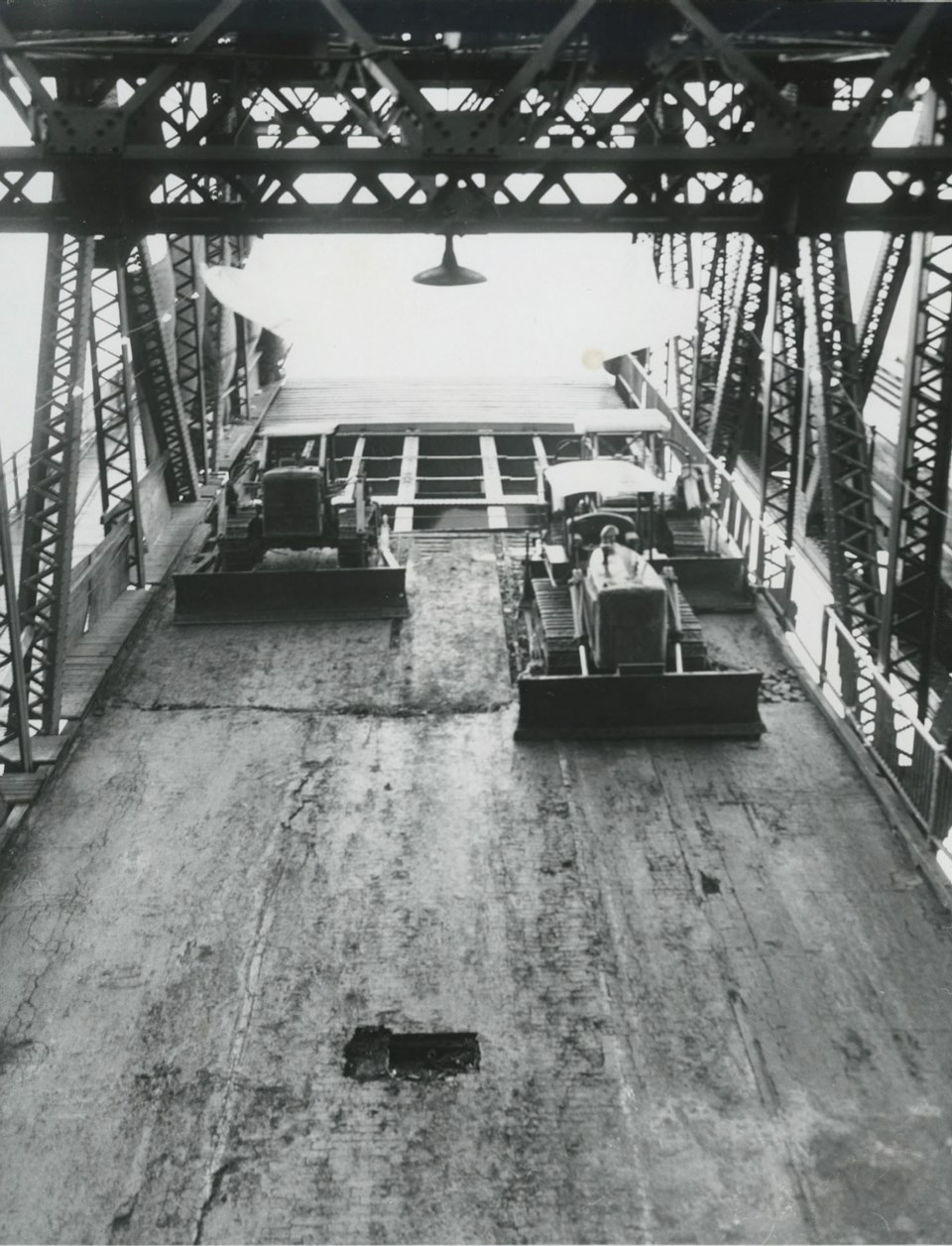This piece was published in 2014 to mark the 90th anniversary of the Johnson Street Bridge.
Saturday marked the 90th anniversary of a Victoria landmark — the Johnson Street Bridge. Its opening ended a decade of debate and construction.
As early as 1913, the City of Victoria was anxious to replace the rail-only swing bridge that had opened in 1888 to carry the Esquimalt and Nanaimo Railway in and out of downtown Victoria.
The hand-operated swing bridge might have made sense at the time it was built, but it could not meet the needs of the modern city. It did not have space for horse-drawn carriages or motor vehicles, and pedestrians making the crossing had to walk on the tracks.
A new bridge would include a span for motor vehicles, and would result in the realignment of Esquimalt Road, which at the time connected with the Point Ellice Bridge. Long before the new bridge was given approval, it was decided that the work would be done by Strauss Bascule Bridge Co. of Chicago.
Council considered plans for the new bridge for several years. In 1914, voters approved improvements to the old Rock Bay bridge, at the foot of Bridge Street. For motorists and horses, it provided the shortest route between downtown and the western side of the water.
Those fixes were a good move, since the Johnson Street Bridge was destined to spend a year on paper before work began. It was delayed by the financial downturn of 1913, and then by the Great War. It became one of several projects — the old Bay building being perhaps the most visible example — to be suspended until after the war.
It finally went to the voters in January 1920, and won by a huge margin.
“By a landslide majority — probably the biggest ever rolled up in favour of an important bylaw in Victoria — the Johnson Street Bridge was endorsed at the polls yesterday,” the Daily 91Ô´´ reported on Jan. 16, 1920.
Voting for the bridge were 2,984 people, while 443 were opposed.
The new bridge, with a price tag of $720,000, was seen as a major factor in the expansion of Victoria. The land across the water from downtown — bought from the Songhees First Nation a few years earlier — could then be put to industrial use.
“The passage of the Johnson Street Bridge bylaw removed the last obstacle in the way of the industrial development of the former Songhees Reserve area,” premier “Honest” John Oliver said. He added that the province had already spent almost $1 million on the property so it could be made available to industrial establishments.
The vote came about after extended negotiations between the city, the province and the Esquimalt and Nanaimo Railway. The E&N agreed to contribute $100,000 to the project, and would cover one-third of the operating costs. The province chipped in another $200,000, leaving the city to borrow $420,000 to complete the work.
Not all of the details had been locked down. The deal approved by voters called for a single bridge, to be shared by the railway, vehicle traffic and pedestrians. In the end we had two bridges, side by side.
The agreement with the railway dealt with financial matters and the operation of the bridge — for example, it was not to be opened within 20 minutes before or after the scheduled arrival of a train.
After the bylaw was approved by the voters, Joseph Baermann Strauss was hired to design the bridge. Almost four years later, the bridge was ready.
“Victoria today entered into the realization of a long cherished dream,” the Victoria Daily Times reported on its front page on Friday, Jan. 11, 1924.
“The opening of the highway section of the Johnson Street Bridge not only gave direct communication to the western suburbs but it has rendered possible the efforts of successive municipal bodies over a long term of years to have a trunk thoroughfare from Oak Bay direct to Esquimalt.”
The official opening ceremony was at the eastern end of the bridge, the downtown side. A stream of dignitaries gathered on a small platform, built for the occasion, to hear Mayor Reginald Hayward declare the new crossing open.
Officially, the ceremony dealt only with the highway portion of the bridge, not the railway portion, but it was timed to coincide with the arrival of the train from up-Island. That meant that as soon as Hayward and the others finished speaking, traffic moved right away on both spans.
By opening the bridge’s twin spans, industries such as sawmills and shipyards could have water access. When the spans were down, the bridge provided land access for freight traffic between the E&N yards and the warehouses and industries on and near Store Street downtown. Â
The bridge had wooded decking when it was built. The wood was replaced with an open steel grid, which was lighter on rainy days, in 1966. The bridge was painted black for 55 years, but was given a light blue paint job in 1979.
The rail span, where corrosion was found in 2011, was removed in early 2012.
A 2010 referendum approved a new bridge that will replace the blue bridge.
Along with three vehicle lanes, the new bridge will have on-road bike lanes, a multi-use pedestrian and cycling trail, a pedestrian pathway, and improved safety and accessibility for wheelchairs, walkers and mobility scooters. Â
The new bridge is scheduled to be open in late 2015, when what’s left of the 1924 bridge will be removed, and will fade into history.



